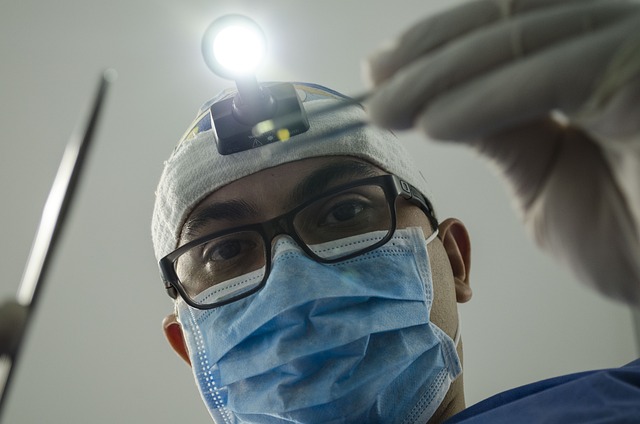When Does Granulation Tissue Develop After Tooth Extraction?
Welcome to our informative article on the development of granulation tissue following tooth extraction! If you’ve recently undergone this common dental procedure or are simply curious about the healing process, you’ve come to the right place. In the next few paragraphs, we will dive into the fascinating world of granulation tissue and explore the key factors that affect its formation. So, grab a cup of tea and get ready to become acquainted with the timeline of this vital part of the healing journey after tooth extraction.
1. Introduction: Understanding the Healing Process after Tooth Extraction
When you undergo a tooth extraction, whether it’s due to decay, damage, or other dental issues, it’s crucial to understand the healing process to ensure a smooth recovery and minimize any potential complications. This article aims to provide you with a comprehensive overview of what to expect after a tooth extraction and how to care for your mouth during the healing phase.
First and foremost, it’s essential to remember that everyone’s healing process may vary, so don’t be alarmed if your experience differs slightly from others. Here are some key points about the healing process after tooth extraction:
- Clot formation: Shortly after the extraction, a blood clot will form in the socket as a natural part of the healing process. This clot acts as a protective barrier, covering the exposed bone and nerves while promoting tissue regrowth.
- Swelling and discomfort: Some degree of swelling, tenderness, and pain in the extraction site is normal, especially within the first few days. Applying an ice pack intermittently can help reduce swelling and alleviate any discomfort.
- Bleeding: It’s common to experience some bleeding immediately after the extraction, which can be managed by gently biting down on a piece of sterile gauze provided by your dentist. The bleeding should subside within a few hours.
- Oral hygiene: Maintaining proper oral hygiene is crucial during the healing process. However, it’s important to avoid the extraction site while brushing and flossing to prevent dislodging the blood clot. Your dentist will provide specific instructions on how to clean your mouth without interfering with the healing process.
By familiarizing yourself with the healing process after tooth extraction, you can take the necessary steps to promote a swift recovery and return to optimal oral health. Remember, if you have any concerns or experience severe pain or complications, don’t hesitate to reach out to your dentist for guidance.

2. A Closer Look at Granulation Tissue: What is it and why does it develop?
Granulation tissue is a crucial part of the healing process when it comes to wounds and injuries. It develops as a response to injury and is composed of a network of tiny blood vessels and connective tissue cells. This tissue is typically pink or red and appears like a granulated surface, thus the name.
But why does granulation tissue develop? Essentially, it is the body’s way of repairing and filling the wound or injury site. The formation of granulation tissue helps to protect the wound from infection, as it forms a barrier against bacteria. Moreover, this tissue secretes growth factors and collagen, which play a critical role in promoting the regrowth of new skin cells. Overall, granulation tissue is a sign that the body is actively working to heal an injury, and it’s an essential stage in the healing process.
- Granulation tissue is made up of blood vessels and connective tissue cells.
- It is characterized by its pink or red appearance, resembling a granulated surface.
- The tissue develops as a protective response to injury.
- It acts as a barrier against infection and helps to promote the growth of new skin cells.
- Granulation tissue is a positive sign that the body is healing and actively working to repair the injury.

3. Timeline of Healing: When Can You Expect Granulation Tissue to Develop?
After a wound occurs, your body immediately starts the healing process by forming a blood clot to stop bleeding. Over time, granulation tissue begins to develop, which is a crucial step in the healing journey. Below is a general timeline to give you an idea of when you can expect granulation tissue to appear:
- Day 1-3: During this initial stage, the wound is still fresh and healing begins. Your body works to control bleeding and remove damaged tissue.
- Day 4-6: Granulation tissue starts to form. You might notice pink or red tissue around the wound as small blood vessels begin to grow and support new tissue growth.
- Week 1-2: The granulation tissue continues to build, becoming thicker and healthier. It plays a vital role in providing a strong foundation for the restoration of the damaged area.
- Week 2-3: By this stage, the granulation tissue is well-established and fills most of the wound bed. It acts as a barrier against infection and helps to facilitate epithelialization, the process of new skin covering the wound.
- Week 4 and beyond: At this point, the granulation tissue gradually transforms into scar tissue, which will continue to remodel and mature over time.
Remember, each person’s healing process is unique, and various factors such as wound size, location, and overall health can influence the timeline. For optimal results, it’s always best to follow your healthcare professional’s advice and keep regular follow-up appointments.

4. Early Healing Stages: First Signs of Granulation Tissue Formation
In the early stages of healing, you may start noticing the first signs of granulation tissue formation. This is a positive sign that your wound is progressing towards healing. Granulation tissue is a crucial part of the healing process as it helps to fill in the wound and create a foundation for new skin to grow.
Here are some key things to look out for during this stage:
- Red and beefy appearance: Granulation tissue usually appears as bright red or pink in color. It may have a shiny and moist appearance, resembling fresh beef.
- Texture: When you touch the wound, you might notice that the granulation tissue has a softer and spongy texture compared to the surrounding healthy skin.
- Formation of tiny blood vessels: Granulation tissue contains numerous small blood vessels that supply oxygen and nutrients to the healing area.
As the granulation tissue forms, you may experience some itching or mild discomfort, which is normal. During this stage, it is important to avoid activities or habits that may hinder the wound healing process, such as smoking or excessive alcohol consumption. Proper wound care, including regular cleaning and dressing changes according to your healthcare provider’s instructions, will promote the continued formation of granulation tissue and aid in the overall healing process.

5. Factors Influencing Granulation Tissue Development: What to Consider
Granulation tissue development is a complex process that is influenced by various factors. It plays a crucial role in wound healing and is essential for the formation of healthy, functional tissue. If you are looking for ways to promote granulation tissue development, here are some important factors to consider:
- Wound type: Different types of wounds require different approaches for optimal granulation tissue development. Understanding the characteristics of the wound, such as its size, depth, and location, can help determine the most appropriate treatment plan.
- Moisture balance: Maintaining an optimal level of moisture in the wound bed is vital for granulation tissue formation. Too much or too little moisture can hinder the development of new tissue. Choose dressings that promote a healthy moisture balance and consider the use of topical products specifically designed to facilitate granulation.
- Nutrition: Adequate nutrition is essential for optimal wound healing and granulation tissue development. Ensure the patient’s diet provides an adequate intake of protein, vitamins, and minerals. If necessary, consult a nutritionist to optimize the patient’s dietary plan.
- Blood supply: Sufficient blood supply to the wound is crucial for granulation tissue development. Poor circulation can impede the process. Implement measures to improve blood flow, such as adequate positioning, regular exercise, and possibly the use of medication or specialized therapies.
- Infection control: Infections can significantly hamper granulation tissue development and even lead to complications. It is essential to follow proper wound care protocols and promptly address any signs of infection. This includes thorough cleaning, appropriate use of antimicrobial agents, and consulting a healthcare professional for further guidance if needed.
By carefully considering these factors and tailoring your approach accordingly, you can greatly enhance the development of granulation tissue, leading to more successful wound healing outcomes.
6. Detecting Granulation Tissue: Symptoms, Changes, and Appearance
Granulation tissue is a common occurrence in the healing process of wounds. Learning to identify the symptoms and changes in its appearance can assist in proper wound care and prevent complications. Take note of the following signs that may indicate the presence of granulation tissue:
- Bleeding: If your wound starts to bleed again after it has initially stopped, this could be a sign of new granulation tissue forming.
- Excessive redness: Granulation tissue often appears as a shiny, beefy red tissue. If you notice an increase in the redness surrounding the wound, it may indicate the presence of granulation tissue.
- Protrusion: Granulation tissue can sometimes protrude above the wound surface. If you observe any raised tissue, it is important to monitor it closely.
By staying vigilant for these symptoms, you can detect granulation tissue early on and seek appropriate medical attention. Furthermore, understanding the changes that may occur during the healing process is crucial. Keep an eye out for the following transformations to the appearance of granulation tissue:
- Decreased wound size: Over time, granulation tissue typically causes the wound to contract, leading to a reduction in its overall size.
- Development of a scab: As granulation tissue progresses, a scab may form over the top. This is a positive sign, indicating that healing is underway.
- Loss of redness: As the wound continues to heal, the granulation tissue will gradually fade in color, ultimately taking on a paler hue compared to its initial bright red appearance.
7. Managing Granulation Tissue: Tips for a Successful Healing Process
If you’ve recently undergone a surgery or have suffered from a wound, you may be dealing with the formation of granulation tissue during the healing process. Granulation tissue is the new connective tissue that forms at the site of the wound and helps in the healing process. While it is a natural part of healing, managing granulation tissue properly is crucial to ensure a successful healing process. Here are some tips to help you handle granulation tissue effectively:
1. Keep the area clean and sterile: It’s important to maintain a clean and sterile environment around the wound to prevent any infections. Clean the wound gently using a mild soap and water, or as per your healthcare professional’s instructions. Avoid using hydrogen peroxide or alcohol, as they can delay the healing process.
2. Use appropriate dressings and bandages: Choosing the right dressing and bandage is essential for managing granulation tissue. Opt for non-adherent dressings that won’t stick to the wound, as they can cause disruptions in the tissue and prolong the healing process. Ensure the dressing is changed regularly, as advised by your healthcare professional, to prevent the build-up of moisture and bacteria.
8. Complications of Granulation Tissue: Potential Issues to Watch Out For
Granulation tissue is an essential part of the wound healing process. However, there can be complications that arise from its formation. It’s important to be aware of these potential issues and to monitor them closely to ensure optimal healing. Below, we have outlined some of the complications you should watch out for:
- Excessive granulation tissue: Sometimes, the body can produce an excessive amount of granulation tissue, resulting in a condition known as hypergranulation. This can delay the healing process and cause discomfort or pain. If you notice an abnormal amount of raised, beefy red tissue around the wound, it’s important to consult your healthcare provider. They may recommend treatments such as silver nitrate cauterization or compression dressings to manage this issue.
- Delayed wound closure: In certain cases, the presence of granulation tissue can hinder wound closure. Granulation tissue fills in the wound and prepares it for the final healing stages, but if it persists for an extended period, it may impede wound closure. Regular wound assessments are crucial in order to identify any delays in healing and take appropriate action.
By being mindful of these potential complications and seeking appropriate medical guidance if necessary, you can ensure that the formation of granulation tissue progresses smoothly and promotes optimal wound healing.
9. Granulation Tissue after Tooth Extraction: Is it a Cause for Concern?
Granulation tissue is a normal part of the healing process that occurs after tooth extraction. It is formed when new blood vessels and connective tissue start to grow in the area where the tooth was removed. While it is expected and generally not a cause for concern, it is important to keep an eye on the development of granulation tissue to ensure proper healing.
Here are a few key points to keep in mind about granulation tissue after tooth extraction:
- Appearance: Granulation tissue often looks reddish or pink and has a soft, fleshy texture.
- Duration: It usually appears a few days after the extraction and can last for several weeks as the healing process takes place.
- Pain: Granulation tissue itself is not typically painful. However, if you experience excessive pain, it is recommended to consult your dentist as it may indicate an underlying issue.
While granulation tissue is generally harmless, there are a few signs that may warrant concern:
- Excessive bleeding: If the area continues to bleed heavily or consistently for an extended period, it is important to seek immediate dental attention.
- Unusual swelling or pus: If you notice significant swelling, discharge, or pus formation, it could be a sign of infection, and you should contact your dentist.
- Delayed healing: If you notice that the granulation tissue is not improving or healing after several weeks, it is advisable to consult with your dentist to ensure proper care and to rule out any complications.
Remember that every individual’s healing process may vary, so it’s always a good idea to stay in contact with your dentist and address any concerns that may arise during the recovery period.
10. Conclusion: Promoting Optimal Healing and Granulation Tissue Formation
The key to promoting optimal healing and granulation tissue formation lies in a combination of effective wound care techniques and supportive measures. By following these recommendations, patients can enhance the healing process and achieve favorable outcomes.
Here are some essential tips to consider:
- Keep the wound clean: Thoroughly cleanse the wound using mild soap and water or a gentle antiseptic solution to prevent infection. Pat the area dry gently with a clean towel or sterile gauze.
- Apply appropriate dressings: Select dressings that create a moist environment, promote oxygen exchange, and provide protection against external contaminants. Consult with your healthcare professional for the best choice based on your specific wound type.
- Avoid excessive moisture: While a moist environment is beneficial, it’s essential to prevent excessive moisture buildup. Proper ventilation and regular dressing changes will help maintain an optimal balance.
- Elevate the affected area (if appropriate): When possible, raise the wounded area slightly above heart level to minimize swelling and promote proper circulation.
- Follow a healthy diet: Eating a well-balanced diet rich in nutrients promotes healing. Ensure an adequate intake of protein, vitamins (particularly vitamin C), and minerals.
Remember, every wound and individual is unique, so it’s crucial to consult with a healthcare professional for personalized advice and recommendations on wound care practices. By adhering to these guidelines, you can play an active role in achieving optimal healing and granulation tissue formation, setting yourself on the path towards a speedy recovery.
Frequently Asked Questions
Q: When does granulation tissue develop after tooth extraction?
A: Granulation tissue typically develops within the first week after a tooth extraction.
Q: What is granulation tissue?
A: Granulation tissue refers to the new tissue that forms during the process of wound healing. It is composed of new blood vessels, fibroblasts, and inflammatory cells.
Q: How does granulation tissue develop after a tooth extraction?
A: Following a tooth extraction, the body initiates a healing response. Blood vessels in the surrounding tissue start to multiply, and fibroblast cells migrate to the area. These cells then produce collagen, which helps build the framework for the development of granulation tissue.
Q: Why is granulation tissue important during the healing process?
A: Granulation tissue plays a crucial role in wound healing as it provides a temporary pathway for the growth of new tissues. It also helps in the prevention of infection and promotes the formation of healthy gum tissue.
Q: Can I see or feel granulation tissue after tooth extraction?
A: It is possible to see or feel granulation tissue near the site of the extracted tooth. However, it is important to avoid touching or disturbing it to allow for proper healing.
Q: How long does granulation tissue take to fully develop?
A: The development of granulation tissue varies from person to person and can take anywhere from several days to a few weeks. It is important to maintain good oral hygiene and follow proper post-extraction care to aid in the timely development of granulation tissue.
Q: What are the signs of healthy granulation tissue?
A: Healthy granulation tissue is characterized by a pinkish, slightly raised appearance around the extraction site. It is crucial to monitor for signs of infection, such as excessive redness, swelling, or pus formation. If you notice any concerning symptoms, it is advisable to consult your dentist.
Q: Can certain factors delay the development of granulation tissue?
A: Yes, various factors can affect the development of granulation tissue, such as smoking, poor oral hygiene, underlying medical conditions, and certain medications. It is important to inform your dentist about any relevant factors that may impact the healing process.
Q: How can I promote the healthy development of granulation tissue after tooth extraction?
A: To promote the healthy development of granulation tissue, it is recommended to follow your dentist’s aftercare instructions diligently. This includes practicing good oral hygiene, avoiding strenuous activities, sticking to a soft food diet, and refraining from smoking or consuming alcohol during the healing period.
Q: What should I do if I have concerns about the development of granulation tissue after tooth extraction?
A: If you have any concerns regarding the development of granulation tissue or experience unusual symptoms, it is always best to reach out to your dentist. They will be able to evaluate your specific situation and provide appropriate guidance or treatment if necessary.
Conclusion
In conclusion, understanding the timeline of granulation tissue development after a tooth extraction is crucial for ensuring successful healing and recovery. While every individual’s healing process may vary, it is generally observed that granulation tissue begins to form within the first week after the extraction. This delicate tissue plays a vital role in promoting blood clotting and new bone formation, which are essential for the long-term stability of the jawbone.
Remember, proper post-operative care is essential to facilitate the development of granulation tissue and promote healing. Following your dentist’s instructions, such as maintaining good oral hygiene, avoiding excessive physical activity, and adhering to any prescribed medications, will help ensure optimal healing.
If you have any concerns or questions about granulation tissue development after your tooth extraction, it is always wise to consult your dentist. They are best equipped to evaluate your unique situation and provide you with personalized advice and guidance.
Ultimately, the development of granulation tissue after a tooth extraction signifies the initial phase of healing. By understanding and supporting this process, you are taking an active role in optimizing your oral health and experiencing a smooth recovery journey.
So, stay positive, stay informed, and take good care of yourself after your tooth extraction. With time and proper care, you’ll be back to your beautiful smile and enjoying your favorite foods in no time!






